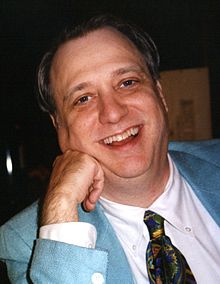J. Richard Gott
John Richard Gott III (born February 8, 1947 in Louisville , Kentucky ) is an American theoretical physicist and astrophysicist .
Life
Gott studied mathematics at Harvard University (bachelor's degree in 1969, summa cum laude) and received his doctorate in astrophysics from Princeton University in 1972 . In 1973/1974 he was a postdoc at Caltech and in 1975 at Cambridge University . In 1976 he was back at Princeton University, where he became professor of astrophysics in 1987. In 2016 he retired. In 1977 he received a research grant from the Alfred P. Sloan Foundation ( Sloan Research Fellowship ).
In public, God is known for speculative ideas on time travel (e.g. with the help of cosmic strings that deform space-time). God believes that time travel is theoretically possible, but not into one's own past (world line). In his opinion, time travel paradoxes would be e.g. B. can be circumvented with the many-worlds interpretation of quantum mechanics. He also wrote a popular science book about it. With Li-Xin Li, he developed a model of a self-producing universe in 1998.
As early as the 1980s, he was known for his ideas of creating the universe as quantum fluctuation from “nothing”.
A controversial prediction formula comes from God, which is known as the Doomsday argument (after God also "Copernican Principle" ). The name comes from the fact that God also made a prediction about the probable time of the end of mankind - between 5000 and 7.8 million years in the future, assuming that Homo sapiens already existed for 200,000 years, and this with a confidence limit of 95 percent.
God received an award for Distinguished Teaching from Princeton University. For fourteen years he was chairman of a Westinghouse and Intel selection committee for the promotion of young scientific talent (National Westinghouse and Intel Science Talent Search), where he himself came second in 1965.
Fonts
- Time travel in Einstein's universe. Rowohlt 2002, English Time Travel in Einstein's Universe: The Physical Possibilities of Travel Through Time. Houghton Mifflin Books, 2002, ISBN 0-618-25735-7 .
- The cosmic web - mysterious architecture of the universe. Princeton University Press, Princeton 2016, ISBN 978-0-691-15726-9 .
- with James E. Gunn : On the Infall of Matter into Clusters of Galaxies and Some Effects on Their Evolution . In: Astrophys. J. , Volume 176, 1972, pp. 1-19
Web links
- Interview in Science Spirit ( Memento from September 28, 2007 in the Internet Archive )
- J. Richard Gott III, Emeritus Professor of Astrophysical Sciences. princeton.edu(short biography).
- Literature by and about J. Richard Gott in the WorldCat bibliographic database
References and comments
- ↑ John Richard Gott III. Dean of the Faculty, Dept. of Physics and Astronomy, Princeton University, accessed February 27, 2018 .
- ↑ Gott, Li: Can the universe create itself? In: Physical Review D , Volume 58, 1998.
- ↑ J. Gott: Creation of Open Universes from De Sitter Space. In: Nature , Volume 295, 1982, p. 304. Atkatz and Heinz Pagels pursued similar ideas in 1982 and before that in 1978 François Englert , Robert Brout in Belgium, Starobinsky in Russia and Alexander Vilenkin in the USA in the early 1980s and 1973 Edward Tryon: Is the Universe a Vacuum fluctuation? In: Nature , Volume 246, 1973, p. 396
- ↑ JR Gott: Implications of the Copernican principle for our future prospects. In: Nature , Volume 363, 1993, pp. 315-319. Comments and replies to this in: Nature. Volume 368, 1994, pp. 106-108. A Grim Reckoning. In: Science , November 15, 1997. It was also found independently by Holger Bech Nielsen and Brandon Carter .
- ↑ The end of mankind, calculated ( Memento from September 27, 2013 in the Internet Archive )
- ↑ Consistent with the mean life expectancy of mammalian species of two million years from fossil records
| personal data | |
|---|---|
| SURNAME | God, J. Richard |
| ALTERNATIVE NAMES | God, John Richard |
| BRIEF DESCRIPTION | American cosmologist |
| DATE OF BIRTH | February 8, 1947 |
| PLACE OF BIRTH | Louisville , Kentucky, USA |
